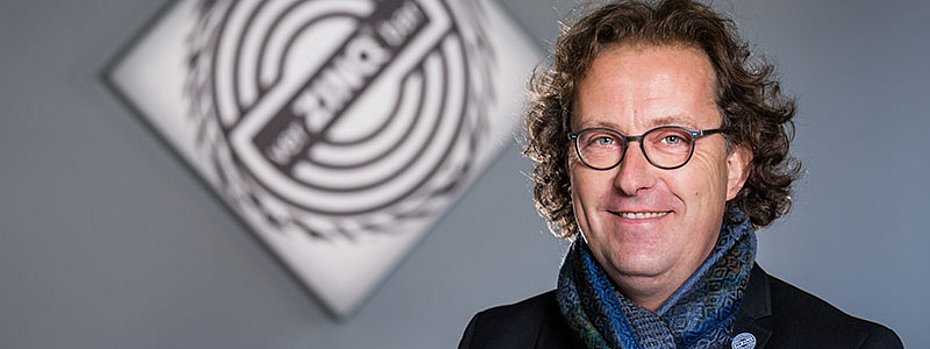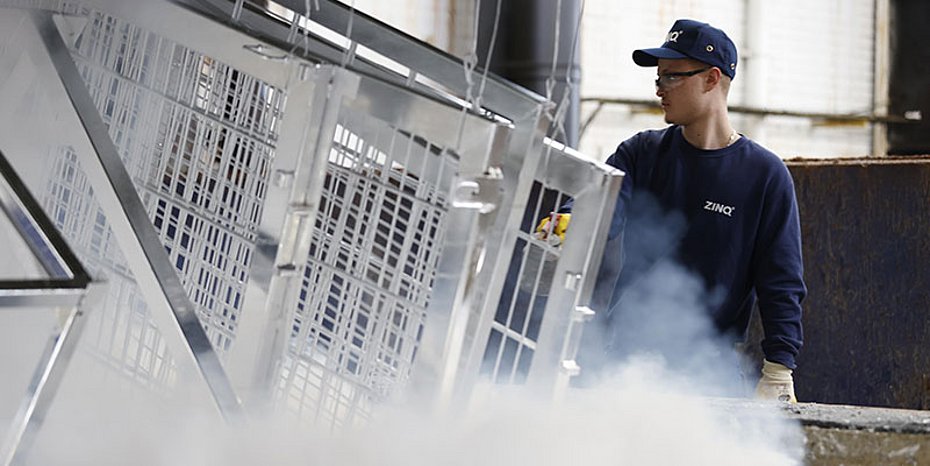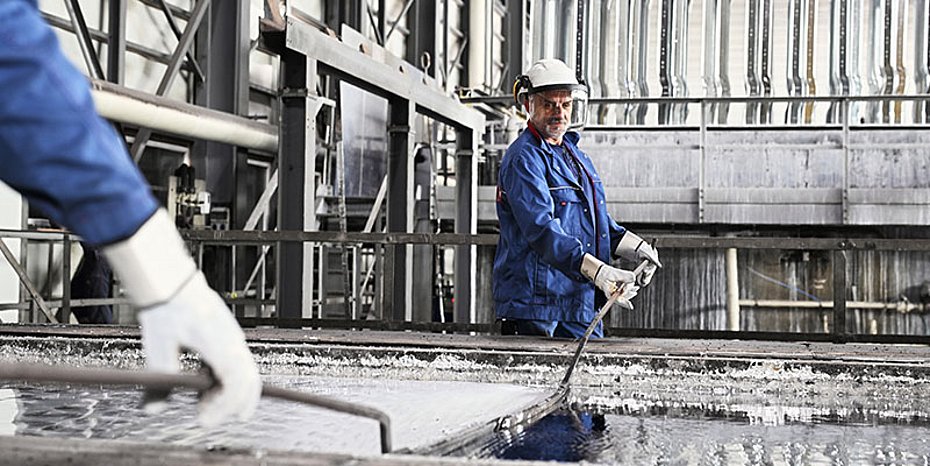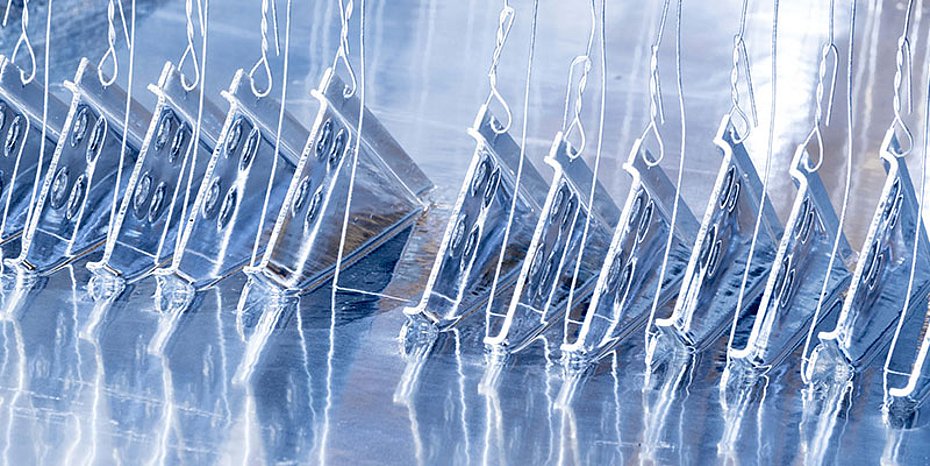Lars Baumgürtel, Managing Partner of the Zinq Group, explains in an interview what is important for a sustainable industrial SME sector after the German federal elections in 2025. After all, SMEs are facing major challenges: High energy costs, excessive bureaucracy, ailing infrastructure and an acute shortage of skilled workers are hampering competitiveness. The energy-intensive company Zinq from Gelsenkirchen, which specializes in zinc corrosion protection for steel, is also feeling the effects.
Lars Baumgürtel: "The economy is the engine of our society, and this engine is increasingly stuttering. Our economy is shrinking - with far-reaching consequences. The geopolitical and economic conditions are changing dramatically - not only worldwide, but also in Europe and Germany. This is why the business community must play an active role in the debate in order to develop a sustainable economic strategy together with politicians and European partners. SMEs play a central role in this, as they are the driving force behind innovation and value creation. The potential and economic power in Europe are huge and should not be underestimated. Together, we have the power to successfully shape change and strengthen our competitiveness. As family businesses, we must raise our voices now: if the industrial base starts to slip, we will all lose."
Lars Baumgürtel: "No, in our economy all sectors are closely interlinked. Focusing on individual sectors is therefore not enough. We are more resilient than other economies due to our diverse economic structure. Our value chains extend from the raw materials industry to the end consumer. That is why we need all sectors - energy and raw material-intensive industry as well as services and trade. The ability to restructure our industry sustainably and competitively at the same time is crucial to maintaining our prosperity. In short: "Business as usual" is not an option. The Federal Government must shape the framework conditions in such a way that entrepreneurial creative power unleashes innovation and investment. Optimal location conditions are a necessary prerequisite for stopping the massive outflow of capital from Germany. There is little time left for this."
Lars Baumgürtel: "Regardless of size and sector, reducing energy costs is the top priority. In concrete terms, this means lowering the grid fees for electricity and reducing additional burdens that distort competition. The CO2 price for natural gas should be frozen to ensure planning security. These measures are essential to ensure the competitiveness of German industry.
In addition, we need an industrial strategy worthy of the name as soon as possible. This must create concrete framework conditions that promote investment and innovation and identify measures to reduce unnecessary bureaucracy and inefficient regulation. It must also provide answers as to how energy-intensive industry can be supplied with CO2-neutral energy at competitive costs and how we can create a reliable supply of raw materials through a competitive circular economy."
Lars Baumgürtel: "We need decision-makers who can respond to the complex interrelationships that characterize the economy and who are willing to seek dialogue with entrepreneurs on an equal footing. There must be no policy that is based on theoretical models and therefore ignores reality. Instead, practical approaches should be pursued that are proportionate and do not promote misallocations or so-called "green lock-ins".
For example, we are currently subsidizing electricity generation from renewables to the tune of EUR 20 billion per year in order to then divert surplus electricity into the ground because generation and consumption cannot be synchronized and the transmission and distribution infrastructure is lacking. So on the one hand, we are spending huge sums on the electricity transition, while on the other hand, only €3 billion will be available for the energy transformation of the entire industrial SME sector by 2030. A new balance must be found here."
Lars Baumgürtel: "We have to afford the transformation, because it is the only chance to maintain a competitive and sustainable industry in Germany and Europe. And that is a central task. Economic growth forms the basis for financing social tasks. Over 60% of total tax revenue, which is currently at an all-time high, comes from transfers from employers to employees, either through income tax or sales tax on consumption. Maintaining this level of tax revenue is only possible through an economy that creates jobs and grows. However, in order to maintain and increase this growth, more funds must be invested in infrastructure and in promoting the transformation of the economy. The newly elected federal government has no more than the next parliamentary term to change course here. New priorities must be set in the budget and sufficient funds made available to support the industrial transformation and thus secure the important jobs in Germany that maintain prosperity.
Climate neutrality is the right goal, but we must make the path to it affordable. Not through bans, regulations and controls - everywhere and at all times. We need more pragmatic approaches for rapid implementation and the revival of entrepreneurial sovereignty. Mistakes will certainly be made on the road to climate neutrality; we therefore also need a new risk culture - both in companies and in the authorities. Transformation does not take place at desks in Berlin or Brussels, but on the ground. A smart framework gives companies the opportunity to optimize their individual transformation path through innovation and investment.
One example: a successful transformation requires CO2-neutral energy - the more, the better. This also includes hydrogen, but the market ramp-up is not progressing fast enough. While we in Germany are still in discussions and oracles about how expensive or cheap hydrogen could be in 10 years, the first Zinq sites in Belgium will be connected to the hydrogen network under construction as early as 2029. In Germany, it is completely unclear whether and when medium-sized industrial companies will be connected to the hydrogen network. That shows our problem: too much theory, too many models, too many think tanks. Too little action."
Lars Baumgürtel: "Regulation at all levels and the multitude of reporting obligations make sustainable business more difficult. Bureaucracy distracts us from the actual task of transformation. Reporting just for the sake of reporting is not effective and doesn't get us anywhere. Even worse, however, is the striving for absolute certainty: there is no risk culture in the administration, but rather the claim to exclude all risks with legal certainty. That's why approvals in Germany take forever. And if something is new and innovative, the administration has no room for maneuver. This is how rules become the nail in the coffin of the economy. It's not just a question of regulations or rule-making, but above all a question of attitude and trust.
A concrete example: In the context of sustainability reporting, we see massive redundancies. European reporting in accordance with ESRS, taxonomy, supply chain due diligence obligations in accordance with CSDDD and CBAM - this is overwhelming for companies that want to transform. The goal must be clear: we need sustainable, environmentally friendly, climate-neutral products. Wouldn't it be logical and absolutely sufficient if we reported exclusively at product level and disclosed all the environmental impacts of products - especially to customers and consumers? According to the EU Ecodesign Regulation, this is possible, even required. This would make the entire company-related sustainability reporting superfluous, which will never work in the important Scope 3 (i.e. outside the corporate sphere) in terms of delimitation. Essentially, companies should be obliged to ensure two things: social fairness as a company in the sense of supply chain due diligence obligations and circular quality in the product, i.e. proof of climate neutrality in the sense of triple zero (no CO2, no waste, no pollution over the entire life cycle). When in doubt: the product never lies!"
Lars Baumgürtel: "Anyone who develops circular products must also be given the opportunity to assert themselves on the market. When it comes to setting the framework for markets in which circular quality is given the appropriate value, it is first and foremost up to politicians. It must create a level playing field in which the externalized costs are taken into account. These costs are caused by products outside the production process, i.e. primarily during use and after use at the end of life. The product that is worse for the environment must no longer be cheaper than the variant that causes significantly less environmental impact over its entire life cycle. In order to change the current approach to pricing products on the markets and include the environmental benefits of products in pricing, all data on the environmental impact of products must be collected, evaluated and fully disclosed. This is already provided for in the Digital Product Passport in accordance with the EU Ecodesign Directive. Product passports are a huge opportunity to give products with circular quality a chance to assert themselves on the market.
We have a concrete example of how far we have already come here: Together with suppliers and our customers, we have developed a circular product passport in which the life cycle footprint is calculated and documented for both the green steel used and the circular zinc surface in accordance with the EU standards for environmental product decalarizations already in force. Our customers receive third-party validated CO2 credits based on existing norms and standards. What is still missing are circular lead markets so that the decision in favor of circular products also pays off economically. It would make sense to have certificate trading and a CO2 price that, on the one hand, burdens more environmentally harmful products and, on the other hand, relieves the burden on products of circular quality. Such emissions trading under market economy conditions already exists in Europe, but CO2 pricing in the so-called EU ETS is currently limited to emissions during production and does not cover the total emissions of a product. However, this could be changed in order to make sustainable products competitive on circular lead markets."
Lars Baumgürtel: "It is important to have a strategic objective for the implementation of the circular economy. The National Circular Economy Strategy provides a framework for this in Germany. However, it focuses primarily on quantitative quotas for recyclates and continues to rely on waste incineration and landfill. It does nothing to change the classification of valuable secondary raw materials as waste and thus continues the prevailing waste management mindset in Germany. The German circular economy strategy thus contradicts, at least in part, the EU Ecodesign Regulation, which is already in force and takes precedence over the national framework and focuses primarily on product quality. The national circular economy strategy must therefore be adapted. After all, a genuine circular economy requires a circular product design in the sense of cradle-to-cradle and taking into account the so-called R-strategies. In addition to repair, reuse, repurpose and refurbish, these include above all redesign and replace, i.e. the further development of products and the substitution of raw materials that are not materially sound. The circular economy only develops its full potential when products have a long useful life and raw materials are saved at the end of their life cycle. We therefore need to focus on "slow the loop" and "close the loop" in order to use raw materials in products efficiently and effectively and to be able to reuse them in new products of the same quality at the end of a product's life."
Lars Baumgürtel: "Germany has a structural energy problem, namely in domestic electricity generation: electricity from wind and sun is volatile, but industry needs a reliable energy supply. On the one hand, we have to import electricity when we have dark doldrums or fire up coal-fired power plants - with catastrophic consequences for the carbon footprint of our electricity system. On the other hand, we generate massive electricity surpluses when wind and sun flood the grids - despite the rather mediocre meteorological conditions in Europe. In addition, generation is not evenly distributed regionally: Too much electricity is generated in the north of Germany, for example, which cannot be transported away due to a lack of sufficient line capacity. We then switch off generation or discharge the excess electricity into the ground. This electricity is also remunerated as phantom power, which cost us over €20 billion in electricity subsidies last year. The truth is that this volatility will increase proportionally as the expansion of wind and solar power in Germany increases. According to studies, the targeted expansion to more than 800 TWh of electricity generation will result in over 400 TWh of surplus electricity. All of this makes electricity expensive for industry. Electricity is only cheap when it is "consumed as produced". For industry, the volatile generation of electricity means price fluctuations without planning security and an electricity price level that massively jeopardizes the competitiveness of energy-intensive industry regardless of size and sector. We therefore certainly need more flexibility on the consumer side, but above all: more investment in infrastructure, intelligent load management and better location planning for energy generation in coordination with large industrial consumers. All of this means massive investments that will make electricity more expensive in the short and medium term and entail the risk of misallocations and green lock-ins. Although the political approach for the further development of the volatile electricity market "use instead of curtailment" is correct in principle, this cannot mean that the demand side alone is given the responsibility for providing the necessary flexibility. It is simply not affordable for industry to take responsibility for the inadequacies of German electricity generation. We therefore need an energy transition with a sense of proportion and honesty when it comes to costs and economic efficiency. We must take advantage of all opportunities to make our energy system sustainable and economically viable for the future. This includes sector coupling, but is not limited to it. If we want to achieve the energy transition and not overburden our industry, we must not forget that more than two thirds of our energy is still generated from gas, oil and coal. Our energy system needs molecules. For good reason: energy in the form of molecules means that the energy is stored directly in the energy carrier and the energy can also be transported to any location at low cost - preferably as gas by pipeline. Nobody has a pipeline network and cavern storage facilities for gases as large as those in Germany. So, in addition to sector coupling, we should focus primarily on energy carrier coupling in order to unleash the corresponding flexibility potential in industry with the aim of competitiveness."
Lars Baumgürtel: "Unlike electricity, gaseous energy sources, such as those used in industrial process heat, are not currently in short supply and are therefore relatively cheap. Of course, they have the disadvantage of emissions if they contain carbon. That is why we need the prospect of green hydrogen. In order to obtain this hydrogen cheaply, we should source it from regions in Europe where it can be produced particularly cheaply. After all, green hydrogen is nothing more than electricity from wind and sun that has been made transportable and storable. If we produce this electricity under optimal conditions, i.e. not in Germany, and then use it to produce hydrogen, green hydrogen can be an economical alternative to natural gas in the future. In addition, cheaply imported green hydrogen can make our energy system more stable and help to cushion the costs of volatile electricity generation. Energy carrier coupling is needed to reduce electricity costs and create the necessary flexibility without forcing industrial demand. Energy carrier coupling refers to the possibility of using several CO2-neutral energy carriers in addition to electricity in energy-intensive applications. One immediately practicable application of energy carrier coupling would be smart power-to-heat: in industrial process heating, gas can be used in the base load in many applications (initially natural gas, then later green hydrogen) in order to then immediately switch to electricity at full power in the event of an electricity surplus. Instead of storing surplus electricity from renewables in expensive, resource-consuming large-scale batteries, we should use this electricity to create value in existing industrial plants. According to a DBU-funded study by Klimahafen Gelsenkirchen, which will be published shortly, flexible hybridized process heat plants are more than four times cheaper than large-scale battery storage!
However, flexible hybridization only works if the process heat with a theoretical capacity of up to 400 TWh is connected to the supply of electricity and green hydrogen at the same time. This is why both the connection capacities for electricity in process heat and the market ramp-up of green hydrogen are so important. And that's why we now also need the infrastructure to import cheaply produced green hydrogen from our neighboring countries, from the EU. Hydrogen makes electricity in Germany cheaper and will save the electricity transition by coupling energy sources."
About the person
Lars Baumgürtel has been a managing director at Zinq since 1992 and has been the sole shareholder of the fourth-generation family business since 2008. As a graduate of the double degree program of the Otto Beisheim School of Management (WHU Koblenz) and the Lyon School of Economics (EM Lyon), his academic focus was on entrepreneurship, marketing and production sciences. The entrepreneur has decades of experience as a serial founder/company builder in international/European markets.
Contact
Zinq GmbH & Co. KG
Nordring 4
45894 Gelsenkirchen (Germany)
Phone: +49 209 319270-0
E-mail: info@zinq.com
www.zinq.com
About Zinq
Specializing in hot-dip galvanizing and coating for more than 130 years, today Zinq is the
market leader in zinc corrosion protection on steel. Zinq
focuses on the development and production of innovative, Cradle to Cradle-
certified surfaces that are used in a wide range of applications in
steel processing.




